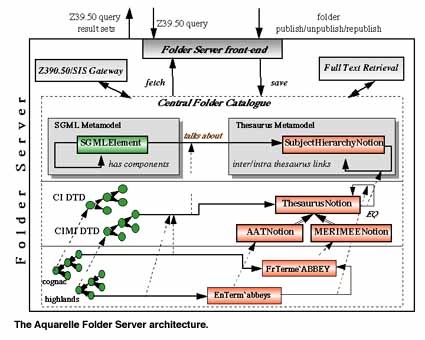The Aquarelle Folder Server
by Vassilis Christophides, Martin Doerr and Irini Fundulaki
The Aquarelle system offers added value to information on cultural material spread all over Europe through the possibility to develop and maintain hypermedia networks of multimedia documents by linking, annotating and commenting relevant pieces of information from distributed resources. The management and dissemination of these so-called digital folders play a central role in Aquarelle.
A folder is considered as a container of primary information elements (text, images, etc) about a specific theme or activity, semantically interlinked into a network of structured collections. Typical themes for Aquarelle folders are all kinds of descriptions of cultural objects or monuments, as well as more complex themes as historical persons, cultural organizations or places during a certain period. Folders in Aquarelle may serve cultural administration, presentation, communication and education, but also the preparation of any kind of exhibition or publication.
Aquarelle folders are implemented using the state of the art standard SGML/XML (ISO 8879). As an advanced feature, the system is designed to support an open number of document types (DTDs). It will be initially evaluated with the management of documents in the form of the DTD from the Consortium for Computer Interchange of Museum Information (CIMI) and Classeur d'Inventaire (CI) of the French Ministry of Culture. Metainformation about Aquarelle folders is also documented in SGML, the Folder Profile DTD. The CIMI DTD is designed for hypermedia documents on museum objects, whereas the CI DTD is dedicated to territory inventory making. The Folder Profile DTD follows the Dublin Core specifications for digital objects metadata (administrative, content, statistical).
Folders are created by commercial SGML editors (eg GRIF, FrameMaker+SGML, Author/Editor, etc) and in the following managed by an Aquarelle Folder Server. Its main functionality is:
- folder publishing to the intended audience
- republishing any folder updates
- withdrawing obsolete folders
- classification of folders according to authorities in use as well as full-text indexing
- querying and retrieving published folders.
During folder authoring, users can issue on the Aquarelle User Client (Z39.50-) queries to archive and folder servers or browse through the structures and hyperlinks of returned folders in order to find further information relevant to the subject. Then they may insert in their folders links to the selected items, under the discipline of the employed DTD. In addition, users can put controlled terms from one or more relevant thesauri in the folder text, using the Aquarelle Thesaurus Browser, another application developed by ICS-FORTH). The use of controlled terminology improves considerably the recall and precision of folder retrieval. Finally, a full text indexing device is invoked (implemented by INRIA), when a folder is submitted to publishing.
The Aquarelle Link Manager co-operates with the Folders Server and User Client to control links against becoming dangling: Once the folder is published, any changes of the folder are regarded as a new version. This republishing action may eventually invalidate already existing references from outside to parts of this folder. In this case a communication will be initiated by the system which requests the other users to withdraw references which will become invalid. The same happens if the folder is withdrawn as a whole in an unpublishing act. The precise communication procedure will be a subject of experimentation a combination of human interaction, conventions and system enforcement.

Querying and retrieval of SGML folders is done under the Z39.50 protocol using the Aquarelle Profile definition of access points for cultural heritage information. There is a close, successful cooperation between CIMI and Aquarelle on the definition of common access points. Currently in folders, access points are mapped to the elements of the Folder Profile structure.
The main components of the Folder Server are the Central Folder Catalogue (CFC) and the Z39.50 Gateway. A dedicated front-end (developed by Euroclid) interfaces the CFC with the Aquarelle Access Server. The CFC is based on the Semantic Index System (SIS) developed by ICS-FORTH, a knowledge representation system for large evolving varieties of highly interrelated data, concepts and complex relationships. Due to its metamodeling capabilities, it allows to map in an elegant way any DTD and its instances, as well as Z39.50 access points and thesauri subject hierarchies into a cross-related semantic net, adding semantics to the syntactic definition of SGML elements in a DTD. The state-full query language of SIS is used to deliver final answers on Z39.50 requests.
The flexibility provided by the generic handling of SGML in combination with the ease of Z39.50 access, and the successful cooperation over the ocean on common respective formats are among the highlights of this project.
Please contact:
Vassilis Christophides
Tel: +30 81 39 16 28
E-mail: christop@ics.forth.gr
Martin Doerr
Tel: +30 81 39 16 25
E-mail: martin@ics.forth.gr
Irini Fundulaki
Tel: +30 81 39 16 37
E-mail: fundul@ics.forth.gr
